1.
Sedimentation measurements
Suspensions measurements
Water samples of 1.7 dm-3 are collected with the water sampler (Niskin
bottle type) from various depths, depending on the sampling design
(usually 0m, 5m, 50m depth). Water subsamples of 100 to 500ml are
filtered on combusted and pre weighted Whatman Glass Microfibre
filters GF/F, 0.7 µm to get concentration of Particulate Total
Mater (PTM). Further procedures as described above with sedimentation
samples processing.
Gravity flows are measured one meter over the sea bottom with Sensordata
currentmeter Mini SD 6000 combined with Seapoint Turbidity Meter
emitting light 880 nm and scatterance angles 15-150 degrees. Empirical
data of solids concentration from Adventfjorden are then used to
calibrate backscatter by plotting PTM (mg dm-3) against FTU (Formazin
Turbidity Units) recorded by Seapoit Turbidity Meter. Received linear
regression equation TPM = 0.9986 FTU+0.6899 (determination coefficient
R2= 0.999) was used to calculate concentration of PTM and gravity
flows.
Sedimentation measurements
The sediment traps are cylinders of perplex, 9.4 cm in diameter and
70 cm in length or 10/100cm.. Equipped with the outlet 100 cm from
the bottom. Traps are deployed vertically in the water column,
attached to the rope with buoy in such way, that allow them to
hang vertically (Zaj±czkowski 2002) Traps are deposited from 12
to 48 hours, depending on the sedimentation intensity. Traps are
deployed below euphotic zone or below the pyknokline, 1m above
the seabed and usually in between in water column. Once retrieved,
the samples is placed onboard vertically, to avoid mixing the collected
sediment, and the excess water is removed through the outlet. Remaining
1 dm-3 of water with the accumulated sediment is placed into the
sampling jar. In case of delay between collection and lab processing
the sediment sample is fixed with 3% of formaldehyde.
In the lab, suspensions subsamples are filtered in combusted and
pre-weighted Whatman Glass Microfibre filters GF/F 0,7 µm, usually
100 to 200ml are filtered. After the filtration, the distilled water
is used to wash out the salt particles from the filter. Some filters
are kept frozen at -18 oC for further analyses (maximum 12 days storage
for chlorophyll a), filters meant for the TSM (Total Sedimented Matter
) analyze are dried in 60 oC to stable weight, weighted, and next
burned in 450 oC for 24 hours to combust the organic particles. After
the burning, the filters are weighted again, and the remaining weight
is considered as ISM (Inorganic Sedimented Matter). The organic matter
amount is calculated as a weight loss in combustion. Additionally,
subsamples of 50 to 100 ml of water are filtered on combusted filters
for particulate organic carbon (POC) and nitrogen (PON) analyses.
Before processing on Perkin Elmer 2400 CHN analyzer, samples are
stored 24 h in vapours of hydrochloric acid to remove of calcium
carbonate, and then ventilated 8 h (Hadges, Stern 1984). Part of
the original suspensions sample (usually 50 ml) is placed in the
glass cylinder for 24 hours for settlement of suspensions, and after
removing the excess water sediment sample is examined under the microscope
for particles indentification.
Literature:
Hadges, J.I., Stern J.H. 1984, Carbon and nitrogen determinations
of carbonate containing solids. Limnol. Oceanogr. Vol. 29: 657-663
Zajaczkowski M., 2002, On the use of sediment traps in sedimentation
measurements in glaciated fjords. Polish Polar Research. Vol. 23:
161-174.
 The
double sediment trap The
double sediment trap |
|
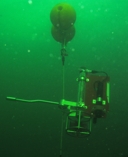 The
currentmeter The
currentmeter |
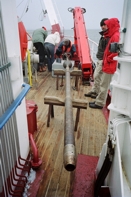 Kullenberg
piston corer, 3 m long section onboard Kullenberg
piston corer, 3 m long section onboard |
|
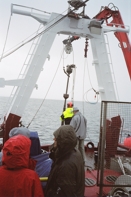 Kullenberg
piston corer ready for lowering Kullenberg
piston corer ready for lowering |
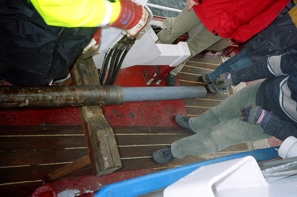 Inner
part of the Kullenberg piston corer,
plastic PVC pipe containing sediment is being cut to sections Inner
part of the Kullenberg piston corer,
plastic PVC pipe containing sediment is being cut to sections |
|
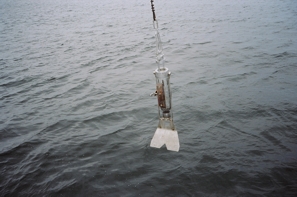 Niemisto
sediment corer ready for lowering Niemisto
sediment corer ready for lowering |
| |
|
|
2. Suspensions measurements
Water samples of 1dm3 are collected with the water sampler (Niskin
bottle type) from various depths, depending on the sampling design
(usually 0m, 5m, 50m depth). Water subsamples of 100 to 500ml are
filtered on pre weighted GFC filters of 045 um. Further procedures
as described above with sedimentation samples processing.
3. Sediment
analyses
Granulometry
table with Wenworth scale of sediment size.
 The
sieves set with shaker
The
sieves set with shaker
Organic
matter content.
Organic matter content is measure in sediment samples of 1g dry
mass, previously dried in 65oC to stabilize weight. Sample is
placed in the marked, pre-weighted china jar in oven and burnt
in 450oC for 24 hours. After the cooling of the oven, the sample
is weighted again in the jar, and the weight loss is considered
to be the organic matter loss in combustion. The organic matter
content is presented as the % of original dry sediment weight. Organic
Carbon Content in sediment - the samples of 1g dry sediment are
analysed.